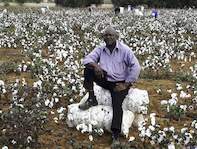There are four main types of commercial cotton planted in the world. These are Gossypium hirsutum, Gossypium barbadense, Gossypium arboretum and Gossypium herbaceum.

Gossypium hirsutum cotton type has relatively short cotton fibres and is used for everyday products. It makes up 95% of the cotton planted in the US and is also the commonly planted cotton in South Africa.
Gossypium barbadense cotton type is also called or extra-long staple (ELS) cotton. It has long fibres and produces superior smooth and strong cloth. It is commonly marketed as ‘Pima’ or ‘Egyptian’ cotton.
Gossypium herbaceum subsp. Africanum (one of two subspecies) is a wild subspecies also known as wild cotton, wildekatoen (Afrikaans), kotini in isiXhosa, litjinda (siSwati) and ugampokwe or umgawuma in isiZulu. The other subspecies, G. herbaceum is a cultivated form.
Wild is endemic to Southern Africa. In Southern Africa where it is used in traditional medicine. The powdered bark of the root is used to stop bleeding and root preparations treat heart palpitations. Previously commercially used for its cotton, G. herbaceum was later replaced by G. hirsutum and G. barbadense.
Gossypium arboreum cotton type also known as tree cotton, is native to the Northwestern parts of India and Pakistan. Used for thousands of years to weave the exceptionally sheer and delicate muslin fabric worn by Moghul emperors, it spread from there to Africa. This species of cotton was used in Nigeria to develop a cotton manufacturing centre in the 9th century.
Cotton Cultivars Planted in South Africa
Five cultivars - all members of Gossypium hirsutum - are used in South Africa cotton production. Recommendations for the use of the best cultivar in a planting region are made by Cotton SA in conjunction with experts in the cotton industry. (Cotton SA represents all role-players in the South African cotton industry. It plays a supportive and advisory role and aims to increase the production of cotton, share knowledge and develop the South African cotton industry).
When recommending a cultivar, aspects such as yield, fibre length and strength, micronaire (thickness of the cotton fibre) and disease tolerance are also considered. Depending on the region, certain cultivars are more suitable to specific climatic conditions depending on the growing season of the cultivar, the production system followed (i.e. irrigation vs dryland) and whether the cultivar provides other characteristics like insect resistance.
All cultivars can be handpicked but for small-scale cotton farmers the cultivar ‘Paymaster’ (PM 3225 – BG2RF is recommended. The other cotton cultivars planted in South Africa (mainly by commercial farmers) include DP1240 B2RF, DP1531 B2RF, DP1541 B2RF and Candia, are all genetically modified to contain the Bt-gene. (The Bt-gene allows the cotton plant to secrete a toxin which inhibits bollworms).
Dr Annette Bennett, technical manager at Cotton SA explains the cultivar choice for small-scale cotton farmers:
Paymaster cottonseed is packed in 5kg bags and cottonseed to plant the refuge area is supplied in an additional bag. (Read more about refuge area or ‘refugia’ below).
This cotton cultivar is hairy and more resistant to leafhoppers, which will provide some resistance against leafhoppers. Seed can be treated with seed treatments that will provide protection against fungal diseases and early-season sucking pests. This cultivar contains the Bt-gene and provides bollworm resistance as well as herbicide (glyphosate) tolerance.
The cultivar Delta18 RF is used for planting the cotton refuge area and is a non-Bt cotton cultivar but is still a genetically modified cotton cultivar, says Dr Bennett.
No conventional cotton varieties (non-GM cotton) are available for conventional planting or organic planting. (Read more on genetically modified cotton in the article ‘What is GM Cotton’).
Refugia in Cotton Farming
A ‘refuge area’ or 'refugia' is an area near the cotton fields planted with a non-Bt cotton cultivar that is not resistant to bollworm, i.e the cotton does not produce the Bt toxin, but shows tolerance to glyphosate, used in weed killers.
These refugia are important in preventing the development of Bt-resistant pests and thereby preventing bollworm resistance in cotton plants.
As mentioned above, ‘Bt’ is produced by a gene in the bacterium Bacillus thuringiensis and some of the DNA or genetic material is introduced into the cotton plant to protect the cotton plant against the bollworm complex, which are the main pests on cotton.
Cotton farmers are required to sign a license agreement with the patent holder on purchasing their cottonseed.
In India, the government has recommended a unique ‘refugia-in-bag’ concept; 25 gm of non-Bt cotton seed is mixed with 450 gm of Bt cotton seed.
By Marinda Louw